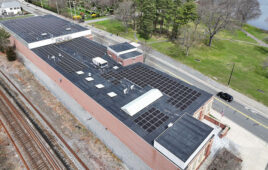Duke Energy Sustainable Solutions, a non-regulated commercial brand of Duke Energy, announced the start of construction of the 250-MW Pisgah Ridge Solar project in Navarro County, Texas.
Once in operation, it will be the largest utility-scale solar facility in Duke Energy Sustainable Solutions’ fleet.
Charles River Laboratories International Inc., a provider of critical research tools and integrated support services that enable innovative and efficient drug discovery and development, has signed a virtual power purchase agreement for 102 MW of the project over 15 years. This commitment will address the entirety of the company’s North American electric power load with clean, renewable energy by 2023.
“We’re excited to continue to grow our Texas solar portfolio, which will provide additional energy resources for the citizens of Texas to help meet their growing demand and need for a more diverse energy infrastructure,” said Chris Fallon, president of Duke Energy Sustainable Solutions. “This project demonstrates how we can address the community’s need for clean energy resources, while providing unique sustainability solutions for customers like Charles River.”
Charles River was advised on the VPPA by Schneider Electric, which assisted the company in its project selection and negotiations.
Two other corporations have signed separate 15-year VPPA agreements for the remaining 148 MW of solar energy generated by the Pisgah Ridge Solar project. All three VPPAs associated with the site will settle on an as-generated basis tied to the project’s real-time energy output.
The engineering and construction for the project are being performed by Moss, while Duke Energy Sustainable Solutions will own and operate the project. The team expects to achieve commercial operation of Pisgah Ridge Solar by the end of 2022.
The project is expected to employ 200 to 300 workers at peak construction. Along with indirect economic benefits that accompany solar project development, such as increased local spending in the service and construction industries, the Pisgah Ridge Solar facility will also have a positive economic impact on the local community by providing significant tax revenues for the Corsicana Independent School District.
News item from Duke Energy Sustainable Solutions





I’ve been watching the electricity utility industry for at least 15 years now. I’ve noticed a trend, as utilities ‘grow’ there seems to be a service split in how they do business say in the cold Northeast or the warm Southwest. Duke is a prime example, in the Northeast, Duke still has serious investment in fueled generation assets. In the Southwest they are either building or buying solar PV farms and I believe some wind farm projects.
All of the major utility players have at one time or another tried: Using the voter initiative process to try and change the particular State’s Constitution to protect the utility’s “regulated monopoly”. Florida, Nevada, Arizona, Michigan were relatively large scale operations. When this move didn’t work with the voters, then there was a rush to build utility scale, (and owned) solar PV projects, so the utilities can still control energy generation and the excuse they use for curtailment of non-fueled energy generation is the “duck curve”. The ‘other’ excuse is after solar PV peak generation ‘they’ the utilities (have) to get fueled generation from the spot market at premium prices, when one digs down, finds that probably the utility has curtailed some of its solar PV or wind generation to use their fueled generation at inflated prices, effectively “controlling” the “duck curve” and the price (you) pay per kWh of electricity. When does ‘regulation’ become usury?
Duke, Dominion, RMP (Rocky Mountain Power), NV Energy, Xcel have all expressed the (way it should be) is in particular residential solar PV, should be credited at the wholesale energy price, usually from 3 to 5cents/kWh and billed at the retail electricity price of from 16 to 25cents/kWh. Of course Duke, Dominion, RMP and NV Energy are heavily invested in by Berkshire Hathaway. This recent AB 1139 in California that for now has failed also wanted solar PV adopters to pay $50 to $80 a month connection fee to the grid. Now as I understand this, when a property is developed, the developer or lot owner pays for all utilities to the property line as part of the ‘development’, then often there are costs to extend the utility up to the building. Who owns that copper wire? How about who paid to have it installed in the first place. As I understand it, the utility is also able to ‘take’ depreciation of assets on infrastructure. How is it the utility gets to claim (your) copper wires to ‘their’ transformer as their infrastructure asset to depreciate? All utilities do this and what it is they get is a paid for utility extension into a development that may well last 30 to 50 years before any repair or replacement of infrastructure is required. Somewhere in the electric utilities bundled costs, there will be something, a fee, charge or tax that is paid for on every kWh of every electric bill for decades. I say charging $50 plus a month for the “privilege” of being connected to the grid is extortion and usury of the retail ratepayer.